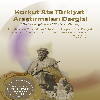S235JR Çeliği için Tornalama İşlemi Sonrası Yüzey Pürüzlülüğü ve Kesici Takım Uç Sıcaklığının Tahmini Üzerine Bir Çalışma
A STUDY ON PREDICTION OF SURFACE ROUGHNESS AND CUTTING TOOL TEMPERATURE AFTER TURNING FOR S235JR STEEL
___
- Abouelatta, O. B., & Madl, J. (2001). Surface roughness prediction based on cutting parameters and tool vibrations in turning operations. Journal of materials processing technology, 118(1-3), 269-277.
- Akkuş, H. (2010). Tornalama işlemlerinde yüzey pürüzlülüğünün istatistiksel ve yapay zeka yöntemleriyle tahmin edilmesi (Doctoral dissertation, Selçuk Üniversitesi Fen Bilimleri Enstitüsü).
- Bilgic, H. H., Sen, M. A., & Kalyoncu, M. (2016). Tuning of LQR controller for an experimental inverted pendulum system based on The Bees Algorithm. Journal of Vibroengineering, 18(6), 3684-3694.
- Bilgic, H. H., Yağlı, H., Koç, A., & Yapıcı, A. (2016). Deneysel bir organik rankine çevriminde yapay sinir ağları (Ysa) yardımıyla güç tahmini. Selçuk Üniversitesi Mühendislik, Bilim Ve Teknoloji Dergisi, 4(1), 7-17.
- Childs, T. (2000). Metal Machining Theory and Applications. Materials Technology, 416.
- Çakır, M., Oral, M., & Aydın, A. (2011) Karanca Koloni Optimizasyon Algoritmaları ile Risk Faktörlerine Bağlı Optimum Hastane Yerleşim Noktasının Bulunması. Engineering Sciences, 6(1), 195-208.
- Dahbi, S., Ezzine, L., & El Moussami, H. (2017). Modeling of cutting performances in turning process using artificial neural networks. International Journal of Engineering Business Management, 9, 1847979017718988.
- Dorigo, M., & Di Caro, G. (1999). Ant colony optimization: A new metaheuristic, evolutionary computation. CEC 99. Proceedings of the 1999 Congress On, 2.
- Goldberg, D. E., & Holland, J. H. (1988). Genetic algorithms and machine learning. Machine learning, 3(2), 95-99.
- Guvenc, M. A., Cakir, M., Mistikoglu, S. (2019). Experimental Study on Optimization of Cutting Parameters by Using Taguchi Method for Tool Vibration and Surface Roughness in Dry Turning of AA6013. 10th International Symposium on Intelligent Manufacturing and Service Systems. 1032-1040
- Jurkovic, Z., Cukor, G., Brezocnik, M., & Brajkovic, T. (2018). A comparison of machine learning methods for cutting parameters prediction in high speed turning process. Journal of Intelligent Manufacturing, 29(8), 1683-1693.
- Karaboga, D., & Basturk, B. (2007). A powerful and efficient algorithm for numerical function optimization: Artificial bee colony (ABC) algorithm. Journal of Global Optimization, 39(3), 459–471.
- Lu, C. (2008). Study on prediction of surface quality in machining process. Journal of materials processing technology, 205(1-3), 439-450.
- Markopoulos, A. P., Manolakos, D. E., & Vaxevanidis, N. M. (2008). Artificial neural network models for the prediction of surface roughness in electrical discharge machining. Journal of Intelligent Manufacturing, 19(3), 283–292.
- Mert, I., & Arat, H. T. (2014). Prediction of heat transfer coefficients by ANN for aluminum & steel material. International Journal, 5(2), 2305-1493.
- Mia, M., & Dhar, N. R. (2019). Prediction and optimization by using SVR, RSM and GA in hard turning of tempered AISI 1060 steel under effective cooling condition. Neural Computing and Applications, 31(7), 2349-2370.
- Öztürk, O., Kalyoncu, M., & Ünüvar, A. (2018). Multi objective optimization of cutting parameters in a single pass turning operation using the bees algorithm. 1st International Conference on Advances in Mechanical and Mechatronics Engineering.
- Preacher, K. J., & Rucker, D. (2003). A primer on interaction effects in multiple linear regression. Retrieved November, 10, 2003.
- Raj, P. P., Perumal, A. E., & Ramu, P. (2012). Prediction of surface roughness and delamination in end milling of GFRP using mathematical model and ANN.
- Singh, D., & Rao, P. V. (2007). A surface roughness prediction model for hard turning process. The International Journal of Advanced Manufacturing Technology, 32(11-12), 1115-1124.
- Wenden, A. L. (1981a). Machining Fundamentals and Recent Advances. (J. P. Davim, Ed.) (Vol. 3). Springer.
- Wenden, A. L. (1981b). Two Neural Network Programming Assignments Using Arrays. In SIGCSE ’91 Proceedings of the twenty-second SIGCSE technical symposium on Computer science education (Vol. 3, pp. 43–47).
- Zadeh, L. A., & Jose, S. (1975). The Concept of a Linguistic Variable II. Electrical Engineering, 357, 301– 357.
- Zain, A. M., Haron, H., & Sharif, S. (2010). Prediction of surface roughness in the end milling machining using Artificial Neural Network. Expert Systems with Applications, 37(2), 1755–1768.
- Yayın Aralığı: Yılda 4 Sayı
- Yayıncı: Konya Teknik Üniversitesi, Mühendislik ve Doğa Bilimleri Fakültesi
HAVA JET İTKİLERİ KULLANARAK MÜHENDİSLİK YAPILARININ AKTİF TİTREŞİM KONTROLÜ
DARBE GENİŞLİK MODÜLASYONU İLE SÜRÜLEN SİSTEMLERE GİRDİ ŞEKİLLENDİRME TEKNİĞİNİN UYGULANABİLİRLİĞİ
Ali KILIÇ, Çağın TAŞKIN, Sadettin KAPUCU
PARÇACIK DARBESİ İLE TİTREŞİM SÖNÜMLEME ÜZERİNE BİR ÇALIŞMA
KABLO İLE SÜRÜLEN DÜZLEMSEL PARALEL BİR ROBOTUN İLERİ KİNEMATİK ÇÖZÜMÜ VE DENETİMİ
Caner SANCAK, Fatma YAMAÇ, Mehmet İTİK
ÇİFT KÖPRÜLÜ ASKI TİP KREN SİSTEMLERİNİN SONLU ELEMANLAR METODU İLE MODAL ANALİZİ
Mustafa ÇAKIR, Selçuk MISTIKOĞLU, Hasan Hüseyin BİLGİÇ, Mehmet Ali GÜVENÇ
DALGIÇ POMPALARDA YAPAY SİNİR AĞLARI KULLANILARAK DENEYSEL AKIŞ ANALİZİ
HAPTİK GERİ BİLDİRİME SAHİP ROBOT ELİN BULANIK MANTIK ESASLI KUVVET KONTROLÜ
Hakan YAVUZ, Cağlar CONKER, Aslıhan KARACA
İKİ ANTENDEN OLUŞAN RADAR SİSTEMİ İÇİN KATLANMA MEKANİZMASI GELİŞTİRİLMESİ
Hünkar Kemal YURT, Ali Emre TURGUT, Eres SÖYLEMEZ, İsmail GÜLER, Ekrem FIRTINAOĞLU
DİRSEK FLEKSİYON HAREKETİNDE KASLARIN MOMENT TAŞIMA KARAKTERİSTİKLERİNİN İNCELENMESİ
